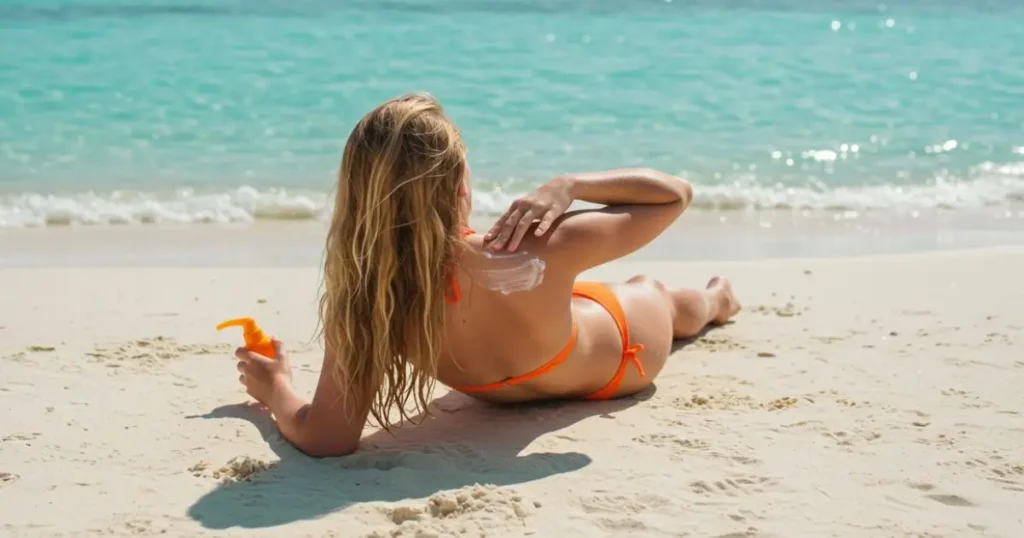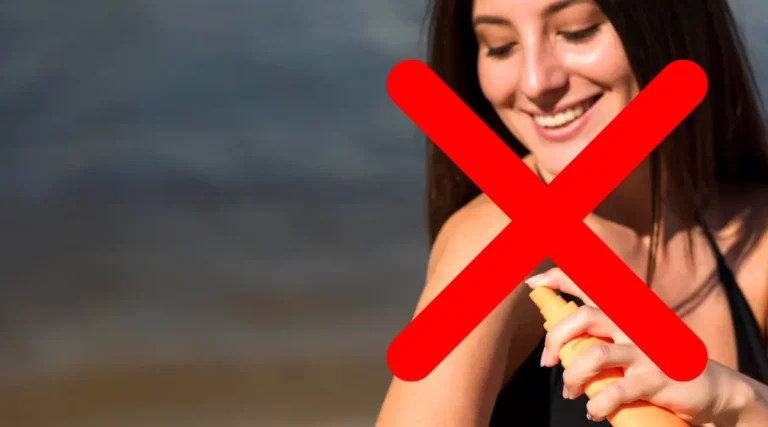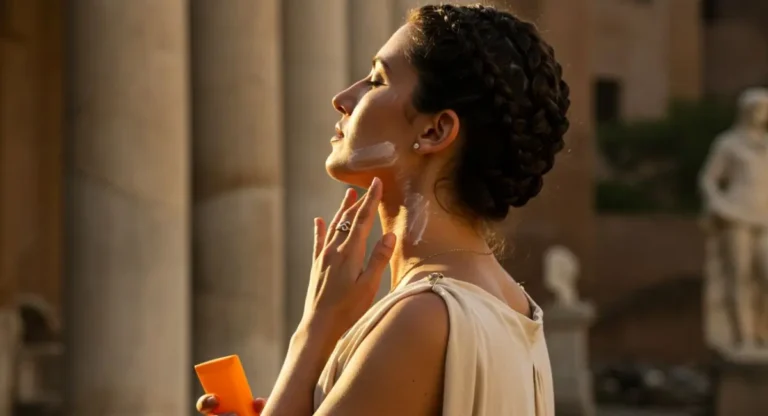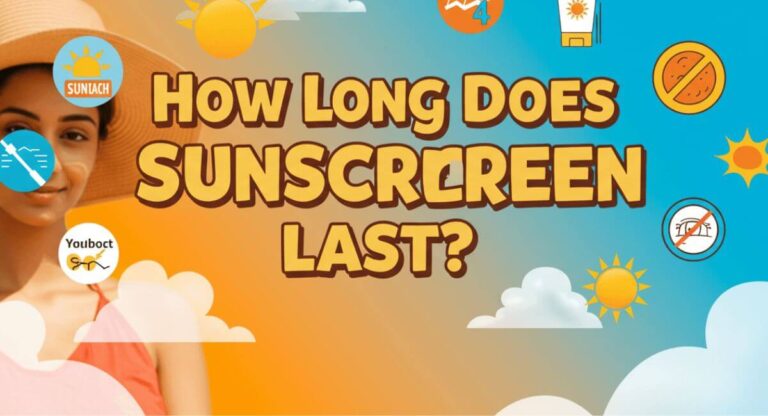Can You Tan with Sunscreen? The Truth About Safe Sun Exposure
Table of Contents
Standing in the sun, feeling its warmth, you might wonder: Can I tan with sunscreen? The desire for a golden glow and skin protection is common. But is it possible to have both?
This article will give you straight answers. We’ll debunk myths and share scientific facts about sunscreen and tanning. Whether it’s a beach day or a backyard BBQ, you deserve to know the truth, and the answer to your question Can You Tan with Sunscreen
Key Takeaways
- Can you still tan with sunscreen? Yes—but UV rays still reach your skin, so timing matters.
- Sunscreen reduces, not eliminates, UV exposure, letting your skin darken safely.
- SPF levels affect how much protection you get while trying to tan.
- Myths about sunscreen blocking all UV rays are not true.
- Smart sun habits help balance tan goals with skin health.
Understanding Sunscreen and Its Role
Sunscreen acts as a shield between your skin and the sun’s harmful rays. But, can you still get tan with sunscreen? To understand, first learn how sunscreens work. They filter out UV radiation through active ingredients that absorb or reflect UVB and UVA rays.
SPF ratings show how well they protect against sunburn-causing UVB. Broad-spectrum labels mean they protect against both UVA and UVB. Using sunscreen right doesn’t block all UV light. This means you can still tan if you apply it correctly.
How Sunscreen Works
Chemical sunscreens soak up UV rays like a sponge, turning them into less harmful energy. Physical (mineral) sunscreens, like zinc oxide, reflect rays away. Neither stops all UV exposure, so can you get tan with sunscreen depends on how you apply it.
Missed spots or low SPF can let UV through, causing tanning. But, too much UV can still harm you.
Types of Sunscreen Formulas
Choose based on your skin type:
- Chemical formulas (e.g., avobenzone) are lightweight but may irritate sensitive skin.
- Physical/mineral options are reef-safe and less likely to clog pores.
- Spray-ons offer convenience but require thorough application to avoid gaps.
Look for water-resistant versions for sweating or swimming.
Why Protection Matters
Even when you want to tan, protection is key to avoid burning and long-term damage. Sunscreen cuts down your risk of skin cancer and slows aging signs like wrinkles. Using sunscreen right lets you control UV exposure, balancing safety with the desire to bronze.
Remember, can you get tan with sunscreen isn’t about avoiding UV entirely. It’s about managing it wisely.

The Science Behind Tanning: What You Need to Know
Your skin reacts to sunlight by making melanin, a pigment. When UV rays hit, melanocytes cells release more of it. This melanin acts as a shield, giving you a tan.
UVB rays cause sunburns, while UVA rays lead to aging and tanning. Sunscreen blocks some UVB but not all UVA. So, can you still get a tan with sunscreen? Yes, but with some limitations.
Even with SPF 50+, some UV rays still get through. This can stimulate melanin, leading to a tan. But, too much exposure can still cause damage.
“A tan is a sign of skin damage, not healthy sun exposure,” warns the American Academy of Dermatology. “Sunscreen reduces but doesn’t eliminate UV effects.”
Sunlight’s energy can harm skin cells. Melanin clumps form to protect against future damage. Over time, these clumps darken your skin. Sunscreen slows this but doesn’t stop it.
Understanding this science helps answer can you still get a tan with sunscreen. The answer is moderation. Sunscreen lowers harm but doesn’t block all UV. Your skin’s reaction depends on your melanin levels and sun time.
Can You Tan With Sunscreen? Debunking Myths
Wondering if you can still tan with sunscreen on? Many myths confuse sun safety with getting a glow. Let’s clear the confusion with facts.
Separating Fact from Fiction
Here’s what science says:
- Myth: “Sunscreen blocks all UV rays, so you can’t tan.” Fact: Sunscreen filters UVB rays that cause burns but allows UVA exposure, which triggers tanning. You can tan with sunscreen on—just not without limits.
- Myth: “High SPF stops tanning completely.” Fact: SPF measures UVB protection. Even with high SPF, gradual exposure lets skin produce melanin for color. Just don’t skip reapplication!
- Myth: “Applying once is enough.” Fact: Sunscreen wears off. Reapplying every two hours keeps skin safe while letting tanning happen over days, not hours.
The Balance Between Protection and Tanning
Protecting your skin doesn’t mean you can’t enjoy a tan. Follow these steps:
- Choose SPF 30+ broad-spectrum sunscreen to block most UVB while letting UVA do its work.
- Build a tan slowly—10-15 minutes daily at first, then increase time gradually.
- Reapply every two hours, even if you’re not sweating. This keeps skin safe without stifling color.
“A base layer of sunscreen doesn’t block tanning—it just reduces burn risk. Use it smartly,” says dermatologist Dr. Lisa Armstrong, MD.
Remember: Can you still tan with sunscreen on? Yes—but only when you prioritize protection first. Myth-busting leads to smarter choices for a safer, healthier glow.

How to Choose the Right Sunscreen for Tanning
Choosing the right sunscreen doesn’t mean you can’t tan. To get a tan with sunscreen, focus on SPF, broad-spectrum coverage, and your skin type. Here’s how to protect your skin while still getting a sun-kissed look.
Understanding SPF Ratings
SPF measures UVB protection, not tanning ability. A higher SPF blocks more UVB but lets some through for a gradual tan. Look for:
- SPF 30 for moderate tanning (blocks 97% UVB)
- SPF 50+ for sensitive skin, still letting through minimal UV rays
Brands like Neutrogena or La Roche-Posay offer formulas that are both strong and tan-friendly.
Benefits of Broad Spectrum Protection
“Broad-spectrum formulas shield against UVA aging rays and UVB burning rays, making them essential for long-term skin health during tanning.”
Always check labels for “broad spectrum.” Brands such as Supergoop! and CeraVe provide effective, non-greasy options. These won’t clog pores or hinder natural pigment development.
Matching Your Skin Type
Skin type dictates sunscreen texture and SPF needs. Use this guide:
| Skin Type | SPF Recommendation | Product Examples |
| Fair/Very Pale | SPF 30-50 | La Roche-Posay Anthelios |
| Medium/Olive | SPF 30+ | EltaMD UV Clear |
| Dark/Deeply Pigmented | SPF 30+ | Badger Sport Mineral Sunscreen Cream – SPF 40 |
Always patch-test new products to avoid irritation. Reapply every two hours, even when tanning, to maintain protection.
Effective Sun Exposure Techniques for a Natural Tan
To get a natural tan safely, use smart strategies. Start by timing your sun sessions to avoid peak UV rays, which are strongest between 10 AM and 4 PM. Instead, go for early mornings or late afternoons when the sun is gentler but still works well.
- Gradual Exposure: Build your tan slowly. Start with 10-15 minutes daily, then increase by 5-10 minutes every few days as your skin gets used to it.
- Track the UV Index: Use apps like UVIndex.org or check the weather to avoid days with UV Index 7+ (extreme risk). Be extra careful on these days.
- Combine Sunscreen with Shade: Always reapply SPF 30+ every 2 hours. Also, use hats, UV-protective clothing, or umbrellas for longer sessions.
- Hydrate and Moisturize: Drink lots of water and apply moisturizers after being in the sun. This keeps your skin elastic and prevents dryness.
Consistency is key—20-30 minute sessions 3-4 times a week. Even with sunscreen, too much sun can harm your skin. Watch how your skin reacts and be patient for a gradual, healthy glow.

Step-by-Step Guide: How to Tan Safely Using Sunscreen
Protecting your skin while getting a tan is all about smart steps. Follow this guide to find the right balance between sun exposure and safety:
Preparation and Skin Assessment
Start by assessing your skin type. Use the table below to find the right SPF for your skin:
| Skin Type | Sensitivity | Recommended SPF |
| Type I (Pale/Fair) | Burns easily | SPF 50+ |
| Type III (Olive) | Medium sensitivity | SPF 30 |
| Type V (Dark) | Rarely burns | SPF 15+ |
Proper Application Methods
- Apply 20 minutes before sun exposure. Let it fully absorb.
- Use a shot-glass amount (about 1 oz) for full body coverage.
- Reapply every 2 hours—even if water-resistant.
Try brands like Neutrogena Ultra Sheer or Coppertone Sport for effective formulas.
Time Management in the Sun
- Limit sessions to 10–30 minutes daily, depending on skin type.
- Avoid peak hours (10 AM–4 PM) to reduce UV intensity.
“Gradual exposure prevents burns and long-term damage,” says Dr. Mary Lupo, a dermatologist at Tulane University.
Follow these steps for a safer, healthier glow without skipping protection.
Tips to Enhance Your Tanning Routine Without Risk
Protecting your skin doesn’t mean you can’t have a healthy glow. Here are some ways to get a tan safely:
- Exfoliate first: Use a sugar or oat-based scrub to remove dead skin cells. This helps your tan look even and smooth.
- Time your sessions: 10-15 minutes of sun in the morning or late afternoon is best. It reduces UV exposure and helps your tan develop slowly.
- Hydrate your skin: Use vitamin E or coconut oil after sun exposure. It keeps your skin moist and makes your tan last longer.
- Layer products wisely: Apply a physical sunscreen first, then a tinted moisturizer with bronzing pigments. This gives a natural-looking boost.
A dermatologist says: “Using smart routines and sunscreen with SPF 30 or higher is safer for a golden glow.”
Use UV tracking apps like UV Index to check the sun’s strength daily. Always reapply sunscreen every two hours, even on cloudy days, to keep your skin protected.
Lifestyle and Diet Factors That Influence Your Tan
Your skin’s ability to tan is more than just sunscreen. What you eat and drink is crucial for a healthy glow. Small changes can make a big difference.
Foods That Boost Melanin Production
Certain nutrients boost melanin, the pigment behind your tan. Add these to your meals:
- Vitamin C: Found in oranges, strawberries, and kale, it boosts collagen and aids melanin.
- Beta-carotene: Sweet potatoes and carrots convert this into vitamin A, fueling skin cell health.
- Niacin (B3): Turkey, peanuts, and lentils support skin repair and a deeper tan.
Importance of Hydration and Skin Nutrition
Drinking water keeps skin plump and ready to absorb sunlight. Aim for 8 cups daily. Pair this with these essentials:
| Nutrient | Role | Food Sources |
| Vitamin E | Protects skin from UV damage | Almonds, spinach, avocado |
| Zinc | Speeds skin repair | Oysters, chickpeas, pumpkin seeds |
| Omega-3 Fats | Reduces sun sensitivity | Salmon, chia seeds, walnuts |
Eat smart and hydrate to enhance your tan’s longevity. Your choices create a foundation for a safer, brighter glow.
Conclusion
Choosing the right sunscreen and following safe sun practices lets you enjoy a natural tan without sacrificing skin health. SPF and broad-spectrum formulas block harmful rays while allowing gradual color. Remember, no sunscreen completely stops tanning—it slows damage, not block UV exposure entirely.
Apply sunscreen 15 minutes before sun exposure, reapplying every two hours. Combine this with hydration and melanin-boosting foods like leafy greens and citrus. Short, frequent sessions in sunlight are safer than prolonged exposure. Brands like Neutrogena and La Roche-Posay offer tested formulas for all skin types.
Your skin’s health depends on balancing protection and enjoyment. By sticking to these steps, you can maintain a golden glow while reducing long-term risks. Prioritize products with FDA-approved active ingredients and check UV index forecasts before heading outdoors.
FAQ
Can you still tan with sunscreen?
Yes, you can still tan with sunscreen. But, it’s important to pick the right one and apply it right. Sunscreen protects your skin from harmful UV rays. This lets you tan safely without too much damage.
Can you get a tan with sunscreen on?
Absolutely! Sunscreen lets you safely enjoy the sun and tan. But, you might tan slower than without it.
Can you still get a tan with sunscreen on?
Yes, you can still get a tan with sunscreen. Just choose a sunscreen with the right SPF and broad-spectrum protection. This way, you can tan slowly while keeping your skin safe.
How does sunscreen affect the tanning process?
Sunscreen acts as a barrier against UV rays. This can slow down melanin production, the pigment that tans your skin. So, you might tan slower, but your skin stays safe from harm.
Is there a difference between tanning with sunscreen and without?
Yes, tanning with sunscreen is safer. It lowers the risk of sunburn and skin damage. Tanning without sunscreen can tan you faster but might harm your skin more.
What type of sunscreen is best for tanning?
Choose a broad-spectrum sunscreen with an SPF of 15 or higher. Opt for lightweight, non-greasy formulas. They feel better in the sun and help you tan while protecting your skin.
How can I tan safely using sunscreen?
To tan safely, apply sunscreen all over and reapply every two hours. Pick sun times when UV levels are not too high. This balances tanning and protection well.
Can I enhance my tan while wearing sunscreen?
Yes, you can enhance your tan safely. Control your sun time, stay hydrated, and use products that help melanin production. All while wearing sunscreen.
Author’s Top Sunscreen Picks
- The Best Polarized Sunglasses for Your Needs: Why Sunglasses Are Essential for Sun Protection (Beyond Fashion!)
- Best Natural Sun Protection for Every Skin Type in 2025 (No Sunscreen Needed!)
- Why Does Sunscreen Burn My Eyes? How to Prevent Irritation in 6 Actions
- How to Prevent Sunburn on Scalp and Protect Your Hairline





